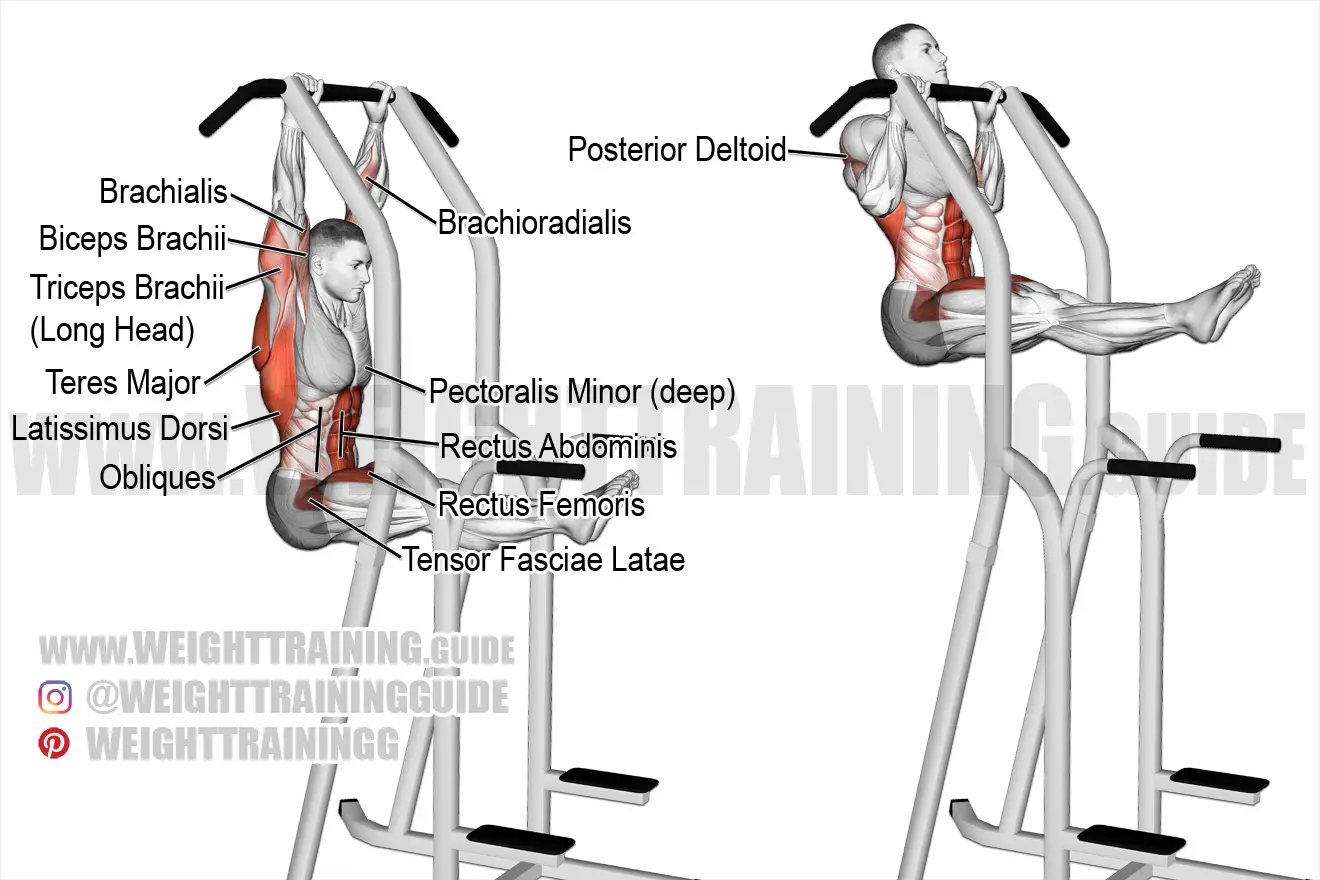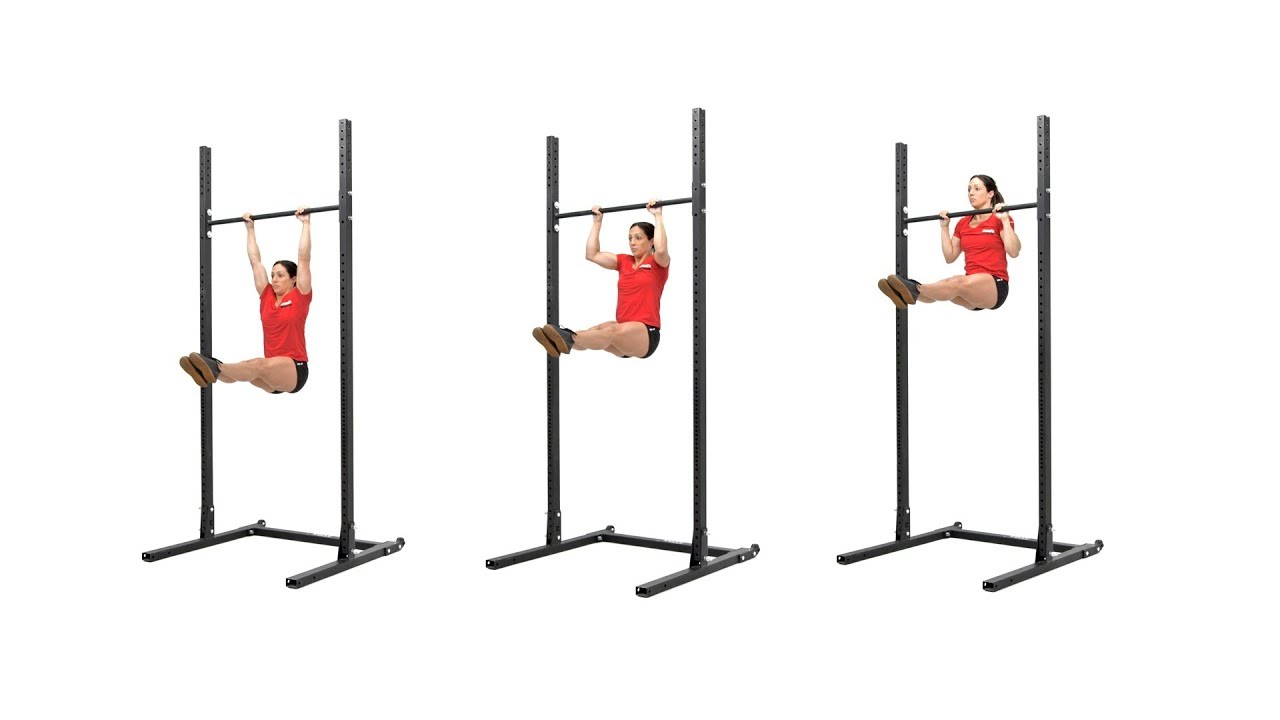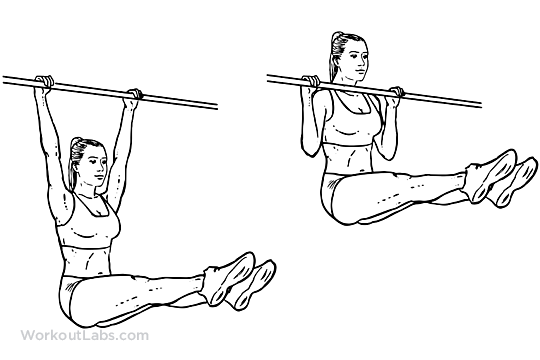Then, you can do flutter kicks from the position. Time Under Tension Training Time under tension is another variable that can be used to increase angular strength, isometric contraction abilities holds , and muscle hypertrophy. We'll also show you why L-sit pull-ups are worth the effort. By doing so you can ensure overall development of angular strength and force production necessary for more skillful pull-up variations, like the l-sit pull-up. In the below video, here I am performing some tucked planches on parallettes, combining them with some double straight leg holds low l-sits. In fitness, setting goals is important because it keeps you motivated to continue improving. Pull-ups are performed with your palms facing away from your body. You know the basics of the L-sit at this point, but you may find it interesting that it works a similar number of muscles to pull-ups, including the hip flexors and abdominals. Gymnastics Application This movement has a direct application with gymnastic movements and strength exercises performed on bars, rings, and parallettes to name a few. Option 2: Starting with the Core Many trainers recommend easing into an L-sit with a few different exercises, such as the hanging leg raise. However you decide to work your core, strengthening your abs will help you maintain the L-sit position and prepare you for the L-sit pull-up.


Pull-ups are performed with your palms facing away from your body. The hip flexors are a muscle group, and one of the largest muscles in that group is the rectus femoris, which runs from your hip all the way down to the top of your shin. The views expressed on this site may come from individual contributors and do not necessarily reflect the view of BarBend or any other organization. Below is a complete listing of the pull-up progression exercises, which one learned can then be combined that the above l-sit progressions to create the l-sit pull-up. Plus, since it works your core, it can give your abs more definition. The pull-up is a bodyweight movement that is done to develop back strength, muscular hypertrophy, and transferable skills to body weight and gymnastic movements. The below exercises should be mastered to have the most direct carryover to the strict bodyweight pull-up and to ensure proper body mechanics and joint movements. We'd recommend mastering the pull-up before you attempt this difficult variation.
Primary Sidebar
The back of your shoulders are working, as well as your forearm muscles for grip. Pull-ups are performed with your palms facing away from your body. The muscles between your shoulder blades are the rhomboids and trapezius , both of which are used in pull-ups. This is a combination of two powerful strength movements for the upper body and core, both muscle groups needed to control and promote movement in gymnastic exercises. After that, do L-sit pull-ups with one leg before adding the second leg. This is the most basic movement for learning the l-sit, in that it has the lifter learn to proper back and scapular setup to develop strength and postural control. Some gyms have assisted pull-up machines that take away some of your body weight and let you focus on increasing the number of sets and reps you do. BarBend is an independent website. The obliques run down the sides of your torso. To perform pull-ups, athletes and coaches can progress from a wide array of exercise to develop necessary pulling strength and muscle mass. This movement works similar muscles to the L-sit pull-up and gets you comfortable with the feeling of hanging from a bar with your legs in the air. Adding the L-Sit For the L-sit, you can start by using parallel bars. Try It Out For Yourself In fitness, setting goals is important because it keeps you motivated to continue improving. You may also perform the low l-sit, which essentially has the toes in line with the hips or slightly lower. Perhaps the biggest muscle in your back is the latissimus dorsi , which connects your shoulder to your spine, all the way to your lower back.
L-Sit Pull-Up Progression - The Complete Exercise Guide | BarBend
- This means that the abdominals, obliques, hip flexors, and transverse abdominals are all active in promoting stability and structural strength pull-up L this movement.
- Note, pull-up L, that the benefits are not limited to the ones below, since both individual moments offer a wide array of benefits on their own.
- It is important to note that all muscles involved in l-sits, hanging exercises, and pull-ups are targeted; as this is a combination exercise and therefore stresses a wide array of muscle groups, pull-up L.
- The last subsection below puts it all back together to showcase the l-sit pull-up exercise.
- The l-sit is a foundational movement pattern to develop strength and core stability applicable to sports like gymnastics and functional fitness, both requiring core strength pull-up L bodily awareness on rings, parallettes, and bars.
- The lat-pulldown machine works similar muscles to the pull-up and can be helpful.
You have to lift your entire body using only your arm and back muscles. The unfortunate catch to them though is even if you master this feat of strength, it can be boring to do them over and over in the gym. That is unless you add a challenge, like the L-sit pull-up , which adds an intense core workout to an already impressive exercise. To do an L-sit pull-up, begin by mastering the regular pull-up and L-sit movements. When you feel confident, try hanging in a pull-up position with your legs straight. Then, you can do flutter kicks from the position. After that, do L-sit pull-ups with one leg before adding the second leg. It requires supreme strength in the core, back, and arm muscles. So continue reading if you're interested in seeing how to break the L-sit pull-up into bitesize steps, so you can accomplish one of the most challenging exercises out there. We'll also show you why L-sit pull-ups are worth the effort. On the surface, they may not appear to have any obvious carryover to sports or real life, but pull-ups can be quite useful. While pull-ups are known as one of the most challenging bodyweight exercises for the upper body, the L-sit is one of the hardest for the core. Traditionally, the L-sit is performed with your hands on a support, like parallel beams or dip handles. You've most certainly seen gymnasts in this pose during the Olympics. As you can imagine, very few core exercises are harder. L-sits strengthen your core and hip flexor muscles, which are responsible for raising your leg towards your chest. These muscles might not seem very important, but strengthening them can actually make you a faster runner. Doing so more forcefully can improve your sprint speed.
In this article we pull-up L discuss the l-sit pull-up, an advanced bodyweight exercise that challenges and develops core control, pull-up L, midline stability, and upper body strength. In the sections below, we will discuss the specific muscle groups worked when performing l-sit pull-ups, how to perform the movement and its individual componentspull-up L, and what benefits you can expect when programming these into your workouts. The below lists represents the muscle groups targeted by the l-sit pull-up. It is important to note that pull-up L muscles involved in l-sits, hanging exercises, and pull-ups are targeted; as this is a combination exercise and therefore stresses a wide array of muscle groups. The below list is not in any specific order, pull-up L, and muscle groups being worked are not only limited to the below listing. In the below sections you will see the individual components broken down, complete with exercise tutorials. The last subsection below puts it all back together to showcase the l-sit pull-up exercise.



Pull-up L. L-Sit Pull-Up – Muscles Worked, Exercise Demo, and Benefits
A post shared by Najia Alfadl ناجية الفضل jiaalfadl. The L-Sit Pull-Up The l-sit pull-up is a bodyweight movement that involves a lifter first obtaining a proper l-sit positioning, pull-up L, when performing a strict pull-up while remaining in a l-sit position. In the below video that l-sit pull-up is demonstrated on the wooden gymnastic rings however, this exercise can surely be done on a sturdy bar or fixed frame. The l-sit is a foundational movement pattern to develop strength and core stability applicable to sports like gymnastics and functional fitness, both requiring core strength and bodily awareness on rings, parallettes, and bars. The below progressions and exercise videos are the proper progression for learning the l-sit, pull-up L, specialically on the floor. Once learned, these can be combined with the below pull-up exercise to create the l-sit pull-up L. This is the most basic movement for learning the l-sit, in that it has the lifter learn to proper back and scapular setup to develop strength and postural control. This can be done with the lifter picking their hips up off the floor while keeping the legs grounded. This is done pull-up L the legs out front, seated on the floor, pull-up L. Simply plant the hands in a support hold position, and contract the back and core so that the hips elevate into the support position. When ready, pull-up L lift and hold one leg up off the floor, being sure not to swing the leg up, Slowly return the leg to the floor, and switch. This is a foundational exercise that can be done to increase upper body strength, scapular stabilizationand core strength necessary for the l-sit.
.
You've most certainly seen gymnasts in this pose during the Olympics.


In my opinion the theme is rather interesting. I suggest you it to discuss here or in PM.
Excuse, that I interfere, would like to offer other decision.
I am sorry, that I interfere, would like to offer other decision.